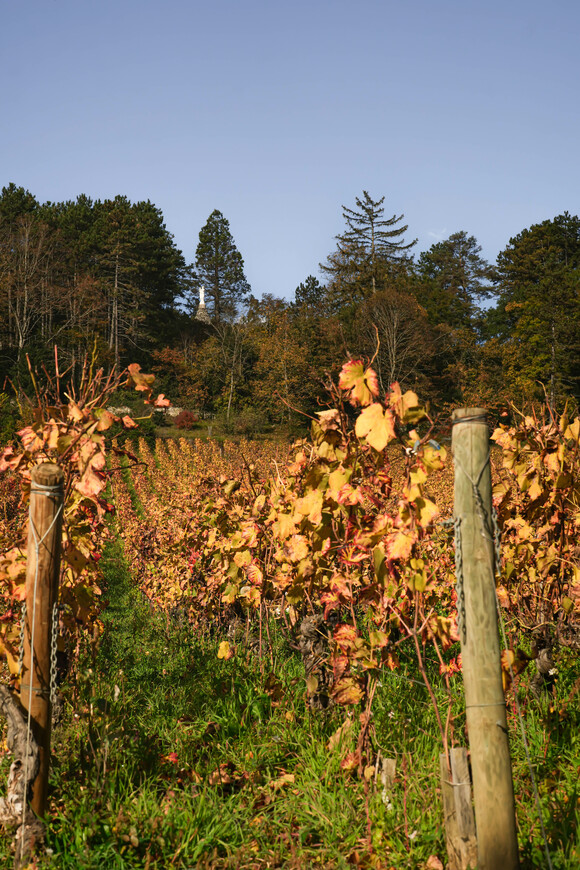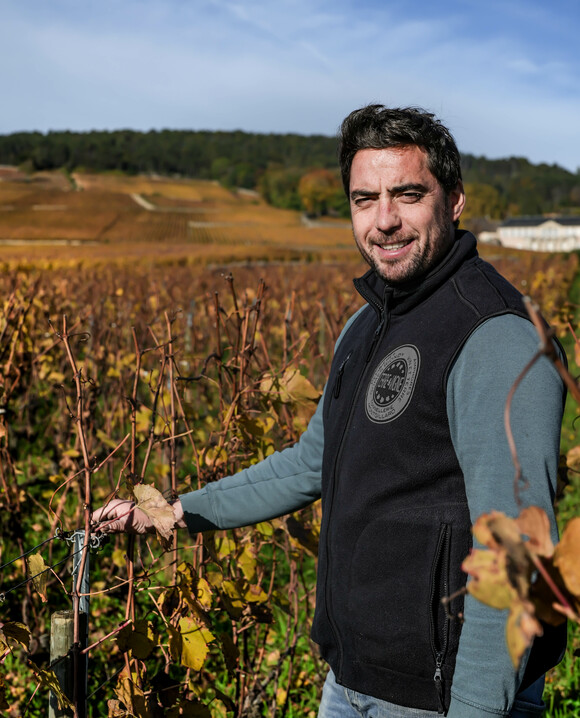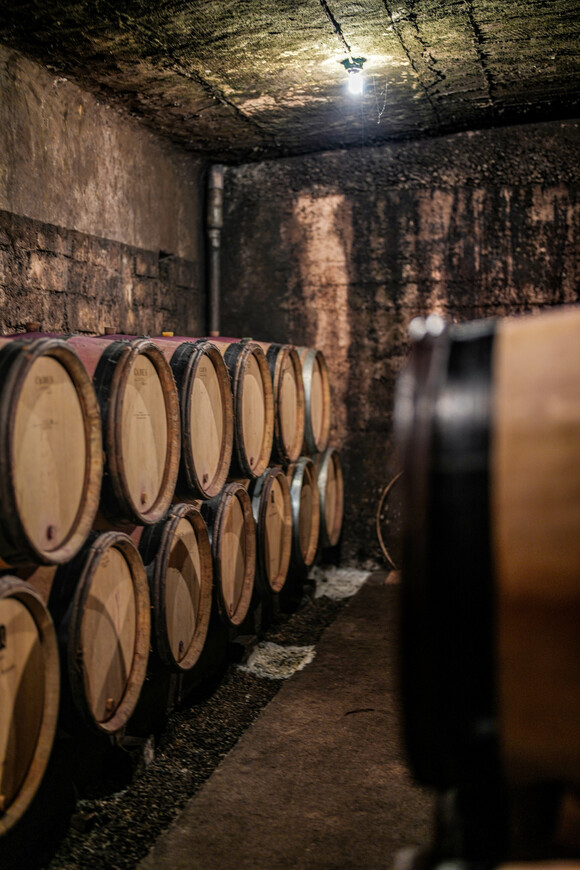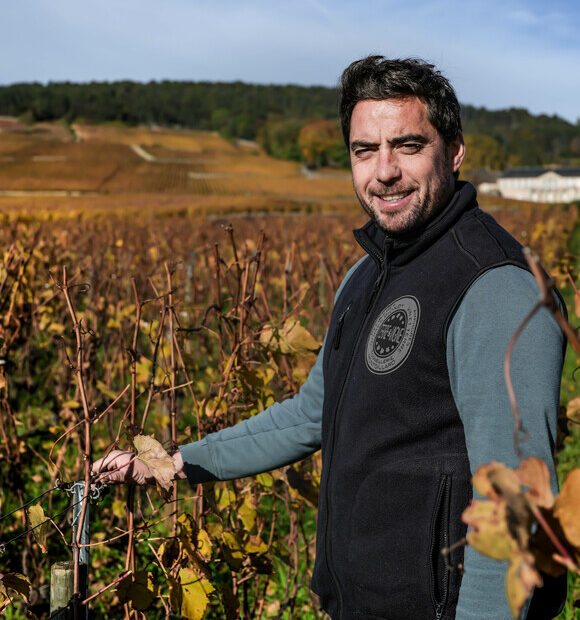The Jean-Marc Bouley winery is certainly one of the most interesting wineries on the Côte de Beaune. For a long time, it was one of the most respected but not really celebrated wineries in Volnay. Jean-Marc Bouley had brought it up to a good level, but remained there to a certain extent until his son Thomas joined in 2002. He had studied in Beaune and then spent some time in New Zealand and Oregon until he returned home and quickly took over the management as well. The real breakthrough came with the 2010 vintage, which was celebrated by all the critics.
Thomas Bouley's way of working
Shortly after joining the winery, Thomas changed fundamental things, especially in the vineyard, which contribute to the refinement of his wines today. This includes the conversion, which is not officially certified, but the organic vineyard work, which is documented with a seal and a declaration of honour.

In 2005, Thomas planted the vines on the lower-yielding Cordon de Royat converted. His plots stand out directly because the foliage wall is much higher than in the neighbouring plots. The tops are usually not pruned, but rolled into the wire frame. One finds loose, well-aerated soils and likewise loose-berried grapes. In this respect, it is no wonder when Thomas quotes Henri Jayer: "There is no secret in wine. The most important point is the work in the vineyard. Then you will find the quality of the vintage."
He ploughs the rows again and again until the véraison sets in, the discolouration of the grapes, and he sets the manual pruning, the breaking out and the trellising in such a way that six to eight bunches of grapes remain on the vine with a balanced distribution. The pruning is done according to the lunar calendar. The harvest is of course done manually. Afterwards, the grapes are sorted again in the wine press on a vibrating table and on a conveyor belt. Depending on the site, he uses around 50 % whole bunches.
After spontaneous fermentation, the wines continue to ferment for between two and three weeks. AllW one from the local wine onwards are matured over two winters before being bottled. The Villages get between 20 and 30 % and the 1er Cru 50 % of new wood. The filling is done with a low sulphur content; there is no fining or filtering.
"There is no secret in wine. The most important point is the work in the vineyard. Then you will find the quality of the vintage."
- Henri Jayer
The course of the year 2019
In Burgundy, many winemakers speak of the magic of years ending in 9. That is also the case this time. For Thomas Bouley 2019 was a unique and very contrasting year. The harvest went smoothly, so the final result more than satisfied the experts. The weather was hot and dry, but the wines show a freshness that will delight lovers of Burgundy. It is accompanied by a drinking flow that will seduce. The only drawback is that the quantity is below average." The winter was mild, so the growing cycle started quite early. The mild temperatures in March, 1.1 °C on average for the whole region compared to normal, allowed the vines to develop well.

The most advanced plots reached the middle bud stage in the first days of April. But then there were frosts once again. Especially the frosts in the morning of 5 April caused damage. Temperatures remained low and frosts occurred again between 12 and 15 April, but with much less damage. The actual vegetation cycle did not start again until mid-April, and it became very hot as early as the beginning of June, with subsequent strong gusts and a cooling, which again caused damage in the middle of flowering.
In July, the heat set in again (2.2 °C above average). Most vines remained in excellent health until harvest, and some rainfall in August supplied the thirsty vines. However, as this rainfall varied greatly from region to region, there were also plots with water shortages.
By the end of August and beginning of September, the majority of the grapes had developed excellently and, above all, the acidity levels were higher than in 2018. In the red wines, fermentation then also proceeded smoothly, albeit at a very different pace depending on the parcel.
The wines of Thomas Bouley
Founded in 1919 by François Bouley, the Domaine has 8.80 hectares in 29 parcels. There is one parcel in Meursault with Aligoté and Chardonnay, the rest is in Volnay, Pommard and Beaune Pinot Noir. The 2019 Aligoté is a white wine that is as fresh as it is silky, which ensures a lot of drinking flow, but also offers elegance and exudes a wonderful fragrance. For the asking price, it is an absolute bargain.
This can also be said of the 2019 Burgundy Côte d'Or It is a pure Volnay and already whets the appetite for the higher-quality Volnays, because it really alludes to the terroir, but remains pleasantly uncomplicated and open in estate wine style.

«Shis aim is to produce fruit, finesse and rondeur.»
The 2018 and 2019 Volnays wonderfully combine the typicity of the vintage with Thomas Bouley's signature. And this can only be described as extremely fine. His aim is to produce fruit, finesse and rondeur so that the wines can be drunk young as well as aged. And you can taste this throughout the entire portfolio.
Thomas Bouley's ambition is to create wines with emotion, and I think he succeeds brilliantly. The pairing Volnay Vieilles Vignes and Volnay Clos de la Cave is a good example of this.
Both wines clearly point towards 1er Cru in their complexity and finesse, but the VVV still forms something like a cross-section of the site, while the Clos much more clearly depicts a specific terroir. While the 1er Carelle sous la Chapelle already brings a lot of finesse to the palate and illustrates Thomas' feeling for the right tannin management - the tannin structure of his wines is really absolutely fine -, the 1er Cru Clos des Chênes Once again, the potential of a Volnay 1er Cru is unmistakably clear.
Even if the 1er Cru Les Fremiers is currently the only Pommard shown in the portfolio, it is nevertheless another highlight. William Kelley sums it up aptly for the Wine Advocate in his article on a 10-year vertical of this site: "Les Fremiers is certainly not the most famous Climat of Pommard. But the location of Bouley's parcel is nevertheless exceptional."
With his intensive work, Bouley has created a wine here that is firm in its structure, yet acts as elegantly as an experienced dancer. It creates the symbiosis of the earthiness and earthiness typical of Pommard and a luminous brightness.
"Les Fremiers is certainly not the most famous Climat of Pommard. But the location of Bouley's parcel is nevertheless exceptional."
- William Kelley
There is no question that Thomas Bouley's wines are among the best in Volnay today. He currently produces perhaps the most balanced and pure wines of the entire appellation. The fact that the 2019 wines are already so open and inviting should not obscure the fact that some of them have potential for decades.
Text and wine expertise: Christoph Raffelt


